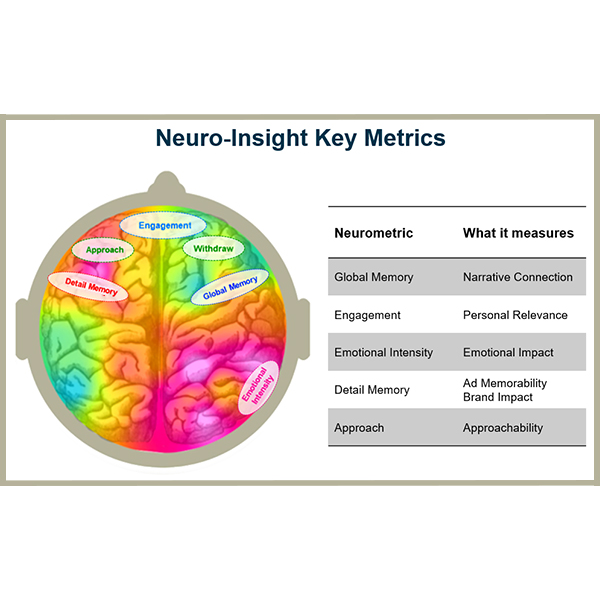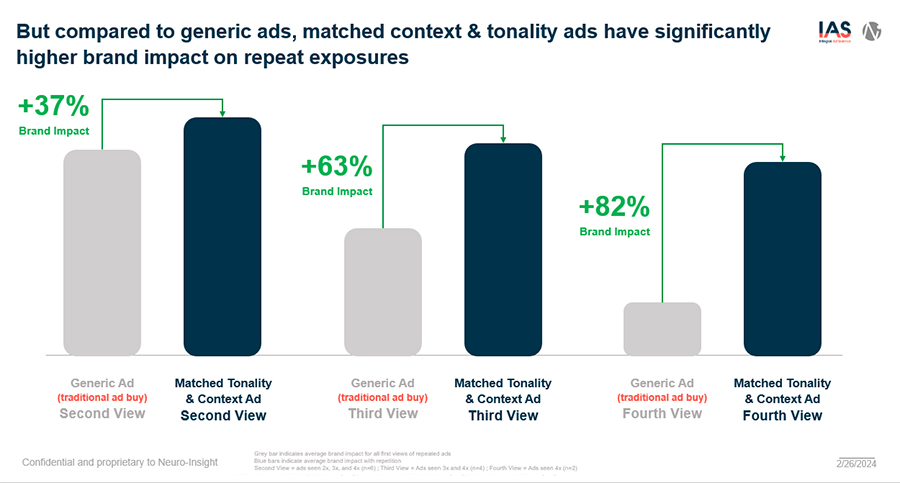IAS and Neuro-Insight Prove “Literal” Plus “Sentiment” Contextual Targeting Lifts Brand Memory Encoding +49%

We all know what contextual targeting is. Going way back, placing a car ad in Motor Trend was what we thought of as contextual targeting. In my first year in the business, I tried to establish a link between ad effectiveness and Nielsen program types, but that approach was not statistically strong. That was verified by an NCS study about five years ago.
Two articles in the ARF Journal of Advertising Research meta-analyze more than 70 studies that prove that sentiment contextual targeting reliably lift ad recall +15%.
The term “literal contextual targeting” is used by Operative’s CCO Ben Tatta to mean the kinds of connections that can be made between ads and media contexts based on literal facts, such as Christmas, automobiles, and other literal objects that can be picked up in ads and in media contexts by computer vision. Ben contrasts this with “psychographic contextual targeting” which is what RMT DriverTags does, using 265 psychological content codes that were distilled by machine learning from over ten thousand words and phrases, based on adoption rates of television series (as measured by set top box data) after receiving a requested program recommendation.
Ben was CEO of 605 at the time one of the world’s largest CPG advertisers tested the efficacy of DriverTag contextual targeting using set top box data to identify the homes in which ads ran, in what programs, and reinterviews of 23,000 of those set top box homes to measure full-funnel effects from first brand mention (increased +62%) through purchase intent (increased +37%) and everything in between. Some of the mid-funnel measures (changes in key brand perceptions) went over +100%.
NCS did a similar study measuring actual sales effects and found average sales lift increases of +36% where DriverTag match between ad and program was above average. The ARF Cognition Council did a six-year analysis of the ability of the RMT taxonomy to explain IRI sales trends and found that RMT predicted 48% of sales changes. Neustar did a random control trial showing that when the ad and the person receiving the ad aligned in terms of RMT indicators, incremental sales increased +95%, and from new to brand customers +115%.
As the inventor of DriverTags (which came out of the 1990s work which won Next Century Media an Emmy® Award for the “pioneering development” of set top box data), I’ve always been interested in finding out how the DriverTags actually work in the brain to cause these types of improvements in advertising effectiveness.
I’ve also been a fan of Dr. Richard Silberstein, the inventor of the patented Steady State Tomography (SST) method Neuro-Insight uses, since Burt Manning introduced me to Richard around the turn of the Century.
In this new IAS study conducted by Neuro-Insight, an ARF award-winning leader in brain measurements of advertising, the types of contextual targeting offered by IAS, literal and sentiment, were tested. I was thrilled to read the results. The full report is availablefrom Neuro-Insight. I will excerpt the results that struck me as the most powerful, but I highly recommend reading the whole report.
Let’s start with nomenclature. In the IAS Neuro-Insight study you’ll see that what I call “sentiment” is called “tone” in this study. Examples given in the report:
- Funny ad in a funny show
- Emotional ad in an emotional show
- Dramatic ad in a dramatic show
Many people use the term “emotion” to describe “sentiment” and “tone”. The 265 RMT DriverTags include 75 nuanced emotions and moods that were each validated to predict program adoption. Other types of DriverTags include human values, character and personality traits, human situations, and content descriptors.
You’ll also see that what Ben Tatta calls “literal” this study calls “context” and gives these examples:
- Show features basketball, ad features basketball
- Show mentions school, ad themed around school
- Program mentions beverage brand, ad for that beverage brand runs during program (product placement aka branded integration)
The main Key Performance Indicator (KPI) in this study was subconscious memory encoding, which also measured a number of other metrics. The study was designed within the scope of CTV.
One of the most dramatic results is that “unrelated ads” – the ads that do not have any match with the program in terms of tone or context as defined above – “break viewers’ neuro-state, causing them to pay less attention and see the ad as an interruption” (If you downloaded the report from Neuro-Insight, see page 11)). These “unrelated ads” (which are the most common types of ad experiences) have negative effects across six key measures, including minus 37% in brand consideration, minus 28% in the important measure of “approach” (neuroscientists agree that along with memory encoding, the approach/avoidance metric is one of the most important in predicting business outcomes).
This is mind-blowing. What it says is that the hundreds of billions of dollars invested in advertising each year are doing more harm than good, because contextual targeting is not being used. Wow.
The report also shows that frequency does more harm than good, unless contextual targeting is used. By the fourth viewing, an unrelated ad has decreased its memory encoding by 26%, while contextually related ads (both tone and context, i.e. sentiment and literal objects on screen) increase memory encoding +82% by the fourth exposure.
Tone alone showed average increases in memory encoding of +14%, +39% for context (match in objects on screen in ad and program) alone, and both tone and context +49%.

Of course, this makes me wonder what the results would have been had DriverTags been used to score the matching of the ads and the program.
Next Century Media had tried experimenting with throwing out some of the 265 DriverTags but that was found to reduce the adoption rate of recommended TV shows. Pat Pellegrini and Steven Millman at Simmons at the time found that none of the 265 DriverTags should be excluded because they all added some incremental predictivity to the prediction of adoption of all 3830 brands in the Simmons study having at least 1000 respondents using that brand. So we know there is some statistical predictive power of certain relevant outcomes in each of the DriverTags.
The 605 study also found that even one single ad exposure caused double-digit increases in first brand mention and purchase intent when the RMT Resonance score (match of at least 30% of the ad’s DriverTags in the program), but a frequency of one had no statistically significant effect when the match rate was lower than that.
Putting all of the pieces together, brands should always use whatever form of contextual targeting they can and should be especially careful of excess frequency in the cases where there is very little match between the ad and the context.
Posted at MediaVillage through the Thought Leadership self-publishing platform.
Click the social buttons to share this story with colleagues and friends.
The opinions expressed here are the author's views and do not necessarily represent the views of MediaVillage.org/MyersBizNet.


